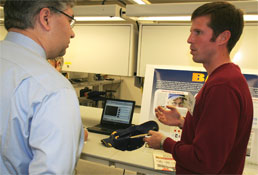Calit2@UCI Debuts New Clean Room, Hosts Open House
By Anna Lynn Spitzer
Irvine, Calif., Jan. 09,2009 -- Calit2@UCI celebrated the opening of its newest lab, BiON, yesterday with an Open House attended by more than 125 people from the campus and surrounding business community.
BiON, the Bio-Organic Nanofabrication Facility, is a 4,000-square-foot, class-1,000 clean room. Unlike traditional clean rooms, in which electronic devices are developed from inorganic materials like silicon, BiON will house research and development of micro-nano devices built from biological and organic materials. These materials include polymers, hydrogels, collagens, proteins and even living tissue, resulting in tiny devices that can provide new and improved healthcare technologies.
|
|
Guests experienced models of some of the miniature devices first-hand, examining samples under optical microscopes set up in the building’s atrium. They also took a “virtual” tour of the new clean room, which can only be entered by those wearing sterile caps, gowns and booties.
Faculty and students from seven other labs in the building welcomed guests as well, demonstrating their research and answering questions.
|
The open labs included:
• CBRL – the Computational Biology Research Laboratory, which uses computational methods to solve complex biological problems, including gene synthesis and protein production;
• Zeiss Center of Excellence, which offers advanced microscopy with state-of-the-art scanning electron microscopes;
• Interactive Animation Lab, which is researches and develops new human/computer interactions and ecological/environmental informatics to educate the public on a variety of topics;
• eMedia Studio, which demonstrated video-based interactive digital media art technology;
• ROC Lab, home to next-generation telemedicine research, as well as intelligent sensor systems that are being used to develop assisted-living technology, ensure the structural integrity of buildings and bridges, and improve the environment;
• Visualization Lab, where HIPerWall, the 200-megapixel display wall is located, as well as a multi-projector display that produces seamless, perfectly aligned, color-calibrated images; and
• Robotics Lab, which houses a motorized wheelchair that employs “smart technology” to teach disabled children to steer it.






